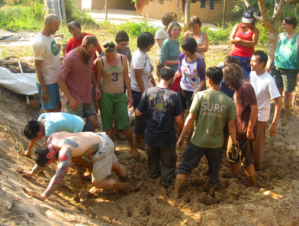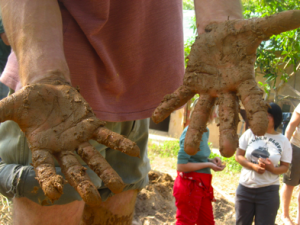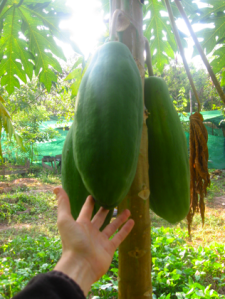Could someone post a photo of the whole class? And maybe an image of your certificate?
Go Ninja Turtles!



Could someone post a photo of the whole class? And maybe an image of your certificate?
Go Ninja Turtles!

Here’s a list of 14 things to do after a Permaculture Design Certification Course. This list came to me from Geoff Lawton of the Permaculture Research Institute of Australia, and Christian Shearer of the Panya Project and I added to it at the January 2009 PDC at the Panya Project.
1. Start at your own back door! Design and Implement!
2. Create or join a local permaculture guild.
3. Travel to other permaculture sites. (UK Permaculture database; PRI projects; Permaculture Activist Directory)
4. Take another PDC or focused course.
5. Volunteer or work in a related field.
6. Give intro talks about permaculture to groups in your area.
7. Practice making designs.
8. Host a course taught by someone else.
9. Apprentice or intern with an experienced designer or teacher.
10. Start a locally impacting enterprise.
11. Do a Diploma of Applied Permaculture Design (more info coming soon!).
12. Get an accredited permaculture degree through Gaia University.
13. Eventually become a permaculture contsultant or teacher.
14. Register as a Tagari-certified teacher.
Would you like to add to this list? Or reorganize it? Go for it the comments!
“Hi Ethan,
I’m doing a research project at Umass for my climatic change class. I want to do a case study of some different permaculture sites that are using permaculture to deal with and adapt to changes in the climate. My professor is skeptical and I really want to knock his socks off with my project. Do you know of any good sites/projects I could research? Also know of any good resources for finding more info on these projects?”
In Australia, look for Crystal Waters Ecovillage. And Melliodora on www.holmgren.com.au – one of the best-documented permaculture sites in the world.
And, Murrnong: A Permaculture Subdivision.
http://www.youtube.com/watch?v=xOW-RdCFax0
[youtube=http://www.youtube.com/watch?v=xOW-RdCFax0&hl=en&fs=1&color1=0x006699&color2=0x54abd6]
And look for Village Homes in California — best example of a permaculture development — there are several books about it.
Good luck!
Ethan

A slew of fresh photos from the incredible Panya Project in northern Thailand, where we’re 9 days into a Permaculture Design Certification Course…
In the mud-pit, the class mixes up a fresh batch of adobe for brick-making & earth-plastering. Clay, sand, rice hulls, water, and feet. Geoffroy
Geoffroy
Students pour adobe into 4x8x16″ brick forms. On a good morning the Panya crew makes 150 bricks. Many of the structures on site are built from 1200-1500 bricks. These will sun-dry… Everything you see in this food forest was planted 2 years ago. Incredible how quickly things grow in the tropics!
Everything you see in this food forest was planted 2 years ago. Incredible how quickly things grow in the tropics! In the food forest, wow. Papaya. We just don’t grow fruit this big in the temperate climate. Wait till you see the jackfruit.
In the food forest, wow. Papaya. We just don’t grow fruit this big in the temperate climate. Wait till you see the jackfruit. One of the many fast-growing nitrogen-fixing shrub species — a pioneer species to provide shade and improve the soil for the longer-term tree crops.
One of the many fast-growing nitrogen-fixing shrub species — a pioneer species to provide shade and improve the soil for the longer-term tree crops. The fruits of tropical labor — Parkie brews up a ginger-chile wine named “The Ginger Temptress”.
The fruits of tropical labor — Parkie brews up a ginger-chile wine named “The Ginger Temptress”.
More from the Panya Permaculture Course soon! Also check out www.panyaproject.blogspot.com for the ongoing COMPOST SAGA —->
Dear friends,
yesterday the national Croatian television showed a documentary about
permaculture and Fukuoka, where also the place where i live now was
included. We started a new ecovillage initiative with 3 grown ups and 2 kids
in an abandoned village named Furuli in Istria, Croatia. The video can be
seen on http://www.facebook.com/ext/share.php?sid=53795486100&h=NJHmv as the
first part, and the second part on
http://www.facebook.com/ext/share.php?sid=51353174895&h=8QMky. we have alsoa web page www.sensemanufacture.com, where Armano’s artistic work is
presented. He use natural materials and waste for his work. The ecovillage
concept is to combine art, permaculture and spirituality, which we already
live here, as a natural and easy sustainable lifestyle. There is a lot of
work which is going on, we want to broaden the garden, secure water supply,
and bring more people here to join. Any volonteering, advice and other
support is warmly welcome.
I wish you all the best for the New Year, just keep on going and never
stop…
Marijana
Yeehaw! More AppleSeed Permaculture students rocking out in the world. The Common Sense Regeneration Project, here is emerging from Eden Vardy, who took the Permaculture Design Course with me in Thailand (same course as Hugo, blogged below!) and is now an associate at Gaia University.
The organizations tagline:
“The best way to predict the future is to invent it“
Hugo took the 2007 Panya Project Permaculture Design Certification course with me, Christian Shearer, and friends. I’m teaching another one there in January…
[youtube=http://www.youtube.com/watch?v=sWj7R4u4Ptw&hl=en&fs=1]
Thanks to KrisCan for putting this video together! View more interviews here: http://www.youtube.com/profile?user=kriscanshow&view=videos
Rudolf Steiner was an incredible visionary — the founder of Anthroposophy, Biodynamic Agriculture, Waldorf education, and more.
Here are the Steiner Archives: http://www.rsarchive.org/index.php
The home of the Biodynamic Farming & Gardening Association: http://www.biodynamics.com/
Wikipedia on Anthroposophy: http://en.wikipedia.org/wiki/Anthroposophy
Seriously. This is one of the most awesome presentations I’ve seen yet at the Financial Permaculture Course.
In a Nutshell: Eric Waldrop of www.locallygrown.net has solved the major challenges of Traditional Farmer’s Market’s, Community Supported Agriculture (CSAs), & Buying Clubs with an easy-to-use piece of internet software. (No nerds required! – Did I saw “wow?”)
The virtual farmer’s market he runs in Athens, Georgia has 60 growers, 1500 customers, and does over $10,000 of sales every week. By Eric’s reckoning, that makes it the largest Farmer’s Market in Georgia and the One of the largest in the Southeast USA. (Did I say “wow?”)
I almost can’t believe the ease and grace with which Eric has used the permaculture principle “the problem is the solution” to transform the challenges of small-scale ecological farming into stunningly simple solutions.
The Food & Agriculture business design group is in complete awe. I’m not even sure if we need investment capital to get this business started! Eric has made this so easy that half the participants (myself included!) are running home to start up their own local virtual farmers markets.
Watch a video explaining locallygrown.net: Click Here
One word descriptions of Eric’s presentation by Financial Permaculture Course participants:
Awesome, fantastic, connective, wow, congratulations, nouveau, hopeful, excited, hunky dory, impatient to do, inspired, valuable, do it, possibilities, resourceful, cool, great, brilliant, cutting edge!!!
WOW.